Most anglers travel aboard to experience good fishing. It is not a cheap process. The cost of transportation and accommodation usually limits the time one is able to spend on a trip. Adding the weather and other environmental factors, it further limits the chance of the trip of a lifetime.
While my visit in Denmark is primarily a personal one, I have used the opportunity to experience a variety of angling opportunities that are available in this country. The fishing is definitely not as good as what most regions of Canada offer in terms of quantity and size. In fact, many Danes have questioned why I come over to fish, when most of them fly to British Columbia to fish for several weeks each year.
Although it would be a lie if I suggest that size and number do not matter, my obsession in these explorations is mostly on new species that I may encounter. Being able to catch a new fish species is an exciting experience, whether they are big, small, or considered ugly or pretty. The large diversity of fish species makes this possible. Since my arrival in early May, I have encountered seven species, including a new one for the book – A tiny Atlantic cod that was by-caught while targeting garfish.
Another species that is on my to-catch list is the European grayling. Several years ago, we took a trip to the western region of Denmark and attempted to catch one. No grayling were sighted but we managed to find some brown trout and discovered the spring creek fishery that is only available in this part of the country. The previous trip was poorly planned. Without much prior research, I armed myself with a 6 weight rod and showed up with some enormous flies. Meanwhile everyone else had a 3 weight and flies that I needed a magnifying glass to see. One of my wishes has been to return with the correct gear so I could finally catch one.
This region, more commonly known as Jutland (Jylland in Danish), is slightly hillier than the area around Copenhagen. Groundwater-fed creeks can be found across this peninsula. Some have never been tampered, while others have been restored since being damaged by the agricultural movement in mid 1900’s. Habitat rebuilding and hatchery supplementing have brought most of these streams back to life with grayling, brown trout and salmon.
This week, we decided to spend two days exploring a stream in Southern Jutland called Grindsted, which is known for its grayling fishery. The trip did not turn out as smoothly as hoped. Both Nina and I picked up a cold just before it. Mother nature decided to make it more frustrating by bringing on the strong wind. The heat wave that we had earlier in the week abruptly ended. We seemed to have picked the coolest days of this spring for our only road trip. As if that would not be miserable enough, I realized that I had forgotten my Goretex jacket halfway into the drive.

Road trip!
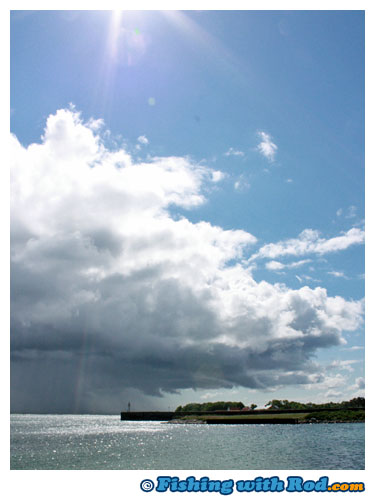
Heavy rainstorms and pockets of sunshine dominated the sky as strong gusts moved the clouds swiftly across the land and sea.
It was not going to be a cheap excursion. Unlike North America, driving is considered a luxury that comes with a steep price in Denmark. Gasoline cost is over $2.00/litre, so people only drive if absolutely necessary. Our trip involved crossing the Great Belt Bridge that requires a toll, which is just over $40.00 each way! While these costs may seem unreasonable, they ensure that people would utilize the resource with moderation and the best public services would be provided.

Pay up!
Crossing the Great Belt Bridge was an adventure itself. We were lucky as usual, a heavy rainstorm hit us just before the crossing began. Combining the low visibility and strong cross wind, the little car ended up drifting from one lane to another without much control. The sweaty palms gripped onto the steering wheel tightly. “Has a car ever fallen off the bridge because of the wind?”, I asked when we reached the highest point.Â
As mentioned in an earlier blog entry, freshwater fishing opportunities in Denmark are significantly more limited and expensive compared to BC. In BC, a basic annual freshwater fishing license gives you immediate access to hundreds of lakes and streams where the likelihood of catching multiple trout is big. Inexpensive conservation surcharges provide additional opporunities in quality fisheries. Stream banks in Denmark are mostly privately owned, so access to its stream fisheries often requires the purchase of a day pass if you do not belong to the club that rents the river bank. A day pass also does not grant you the right to fish anywhere as you wish. Limited river banks where fishing is permissible are drawn out on the map. For this particular river, the cost of a day pass is $20.00.
Once obtaining the passes, I was eager to make a few casts so it was a no brainer that I wanted to head to the river. I arrived at the spot that was recommended to me within minutes. The creek is indeed tiny. The width was no more than ten metres. The river banks are high and covered in tall vegetations. A closer examination of the creek made me scratching the head. The river bed is mostly made of sand and clay, while patches of weeds could be seen. The depth is perhaps half to one metre. The water was close to gin clear. Where would the fish be hiding?
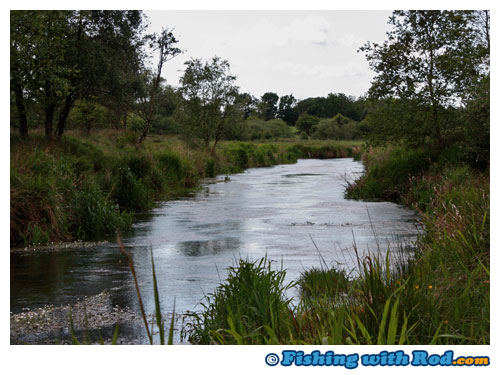
A typical Danish stream.
I began walking downstream. The more I walked, the more baffled I became. Finally I came upon a bend, where the stream current seemed to vary slightly. I decided to sit and study it more. Suddenly a small rise appeared at the bend. A minute later, it appeared again. Shaking with excitement, I tied on a small dry fly and hoped that the same fish would go for another hatch. Standing further downstream, I casted up so it would drift into where the previous rise was. The wind was not making it easy. The fly landed too close to the bank in the first two attempts.
After some adjustments and a few curses, it finally landed at where I wanted it to be. It drifted through the run with no reaction. Several more drifts also did not yield the result that I was hoping for. Just as I was about to move on, one rose up to the fly but I had already stopped concentrating. It was a pathetic miss. I quickly flicked the fly back upstream. As if it was calculated, the fish came up again. This time, I was quick on the hookset and the new 2 weight rod was dancing in no time. It was a small fish, not much longer than eight inches. I was not sure what it may be. I saw spots on the back, was it a brown trout? When it reached the muddy shoreline, I was pretty happy to see that it was my first ever grayling. The horizontal line patterns, the unique dorsal fin, I’ve seen them in photographs many times, but it definitely look way cooler in real life.
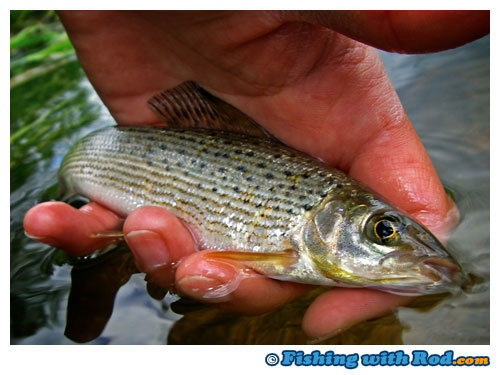
With one fish brought to the hands already, I thought that the rest of the trip was going to be just as easy. I returned to our cabin for a quick supper soon after.
Nina and I returned that evening for the hatches. The evening time is known to be quite good as many fish rise for a good feed of insects.
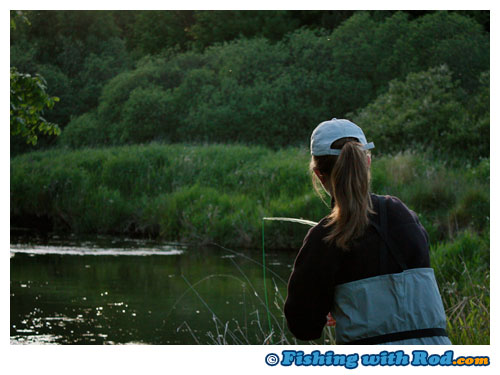
I decided to tie a nymph on Nina’s line, so it would be easier for her to fish. She only casted downstream several times before missing a tug. A few casts later, the same fish darted out of the weedbed for another bite. This time it was not so lucky. The fish leaped straight out of the water and landed on a nearby weed patch.
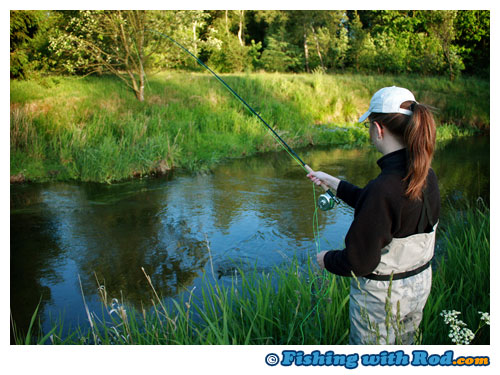 Â
Â
It was yet another tiny fish, but this time it was a brown trout, which was also Nina’s first ever.
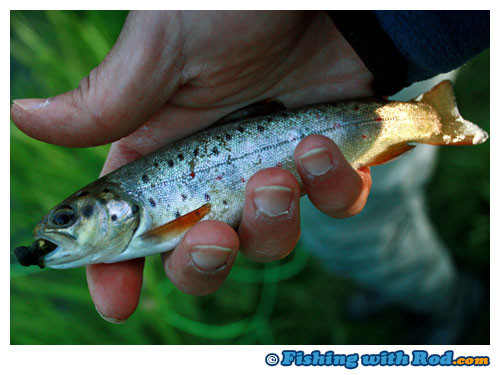
Our evening session ended much earlier than we had anticipated because the cold wind was no longer tolerable while being sick. Perhaps the second day would bring better luck?
The next morning, I ventured out alone at 10:00am. Although others have recommended me to only focus on the evening, since most hatches and surface feeding happen during that time. I wanted to scout the river some more and see if I could entice a fish or two anyway in late morning, perhaps by nymphing.
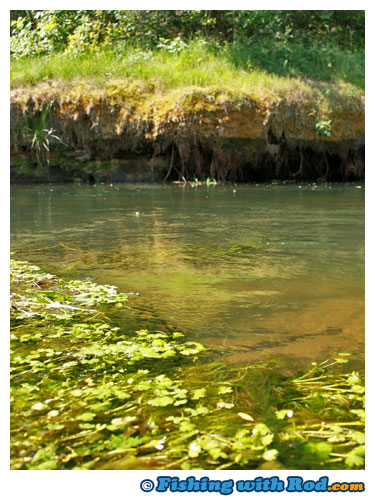
Perhaps they are hidden under the weeds?
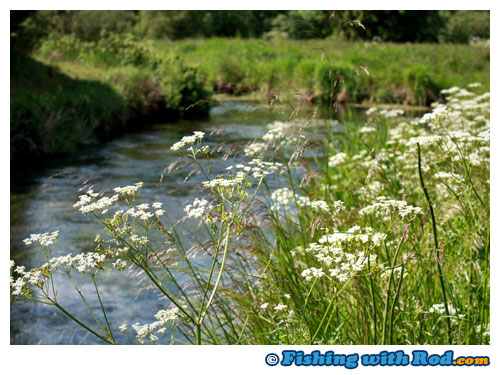
Signs of spring.
I returned to the stretch of river where Nina hooked the tiny brown trout, because I also spotted a couple of fish that evening. As I walked along the edge, I inspected the water and looked for signs of movement on the river bed. Even though the water is only knee deep at most places, it was actually quite difficult to spot a fish. The tinted water only allowed me to see the bottom clearly at times. Weeds that are anchored to the bottom drifted from side to side, which could easily be mistaken as fish. It only took a short while before I came across some exciting discovery. At the exact same place where I saw a fish on the previous evening, I spotted it yet again. Not only did I spotted a fish, I stumbled across a dozen of his companions! It was a school of grayling, ranging from tiny fingerlings to fully grown adults. The large ones seemed to be at least 16 inches in length. They sat quietly on the bottom of a gully and darted in and out of the weeds occasionally.
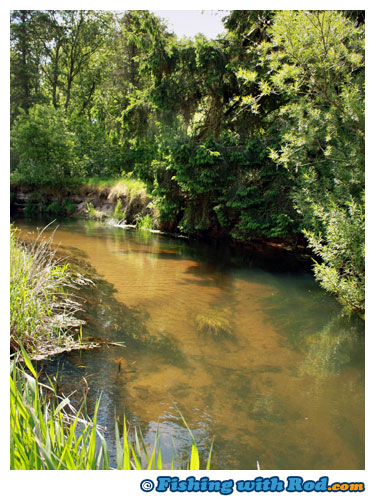
A rather fishy looking spot.
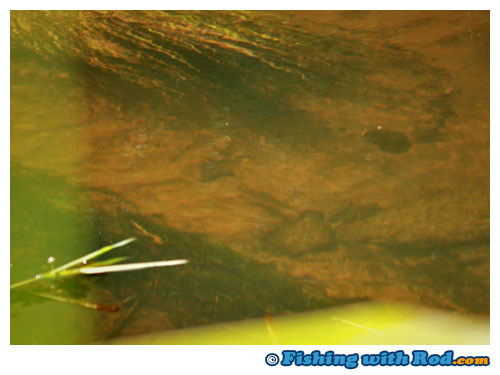
There’s one!
I carefully tied onto a nymph that resembles a shrimp and proceeded to place it above the gully so it would drift into it. They should bite right? There is no reason that a fish wouldn’t take a food item when it is placed in front of its face. They do that back in BC all the time! Not so in this case. After numerous drifts and strips, the tug never came. I walked back downstream to check if they had moved. All of them were still at the exact same spot, behaving as if they were sleeping.
Frustrated, I walked further upstream to other spots and also found other fish holding in them. There were not as many, but they were just as inactive. The rest of the morning involved plenty of fish watching and no catching. I returned to the car around lunchtime and found three anglers enjoying their lunch by the river. They also reported a lack of catching. Too cold perhaps, one angler suggested. At least that was a bit of consolation! It always feels good when others are also not catching, because then the blame can be put on the fish instead of the angler.
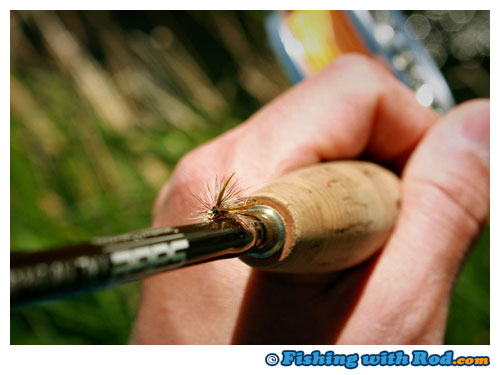
A tiny dry fly on the 2 weight is a typical setup for this fishery.
Rainstorms rolled into the region that afternoon so we stayed indoor and sorted all the lovely scenery photographs that I had taken. Always bring a camera to fishing of course, it is a good time killer when there are no fish to catch.
After supper, I returned to the river and was determined to fish until sundown (11:00pm) so I could fool a riser if there was going to be one. The wind was still howling loudly and the air is as chilly as that morning. The chance of a strong hatch was basically slim to none, but it was worth a try anyway since I did not have another evening.
Like a dog sniffing his way back home, I sprinted back to where the fish were. They were still there. I flicked out a dry fly to see if any would be willing to take a bite. Each drift yielded the same result, these fish were not tempted.
Somewhat deflated, I decided to explore further upstream and came across a stretch of water that was heavily covered with trees on both sides. Perhaps the shaded water would hold some unsuspecting fish. I stuck my head out and stared for a minute. There were indeed several fish actively circling in the run. Optimism re-emerged, I positioned myself carefully so I could send the dry fly out without catching a branch or spooking these fish. Just when I was about to haul forward after the first back cast, I felt that dreadful tightening of the line. The fly was tucked away between branches, out of the reachable height. I immediately broke it off, as any attempt to save it would be useless. I tied on another and began flicking it out. The fly landed as perfectly as I wanted. It slowly drifted into the striking zone. Two fish suddenly swam around in a panic manner, they had obviously seen the fly. Despite of the commotion, none rose to strike it. Once it was out of the strike zone, I slowly picked it up and proceeded to flick it back upstream. Just as I was ready to shoot it out after two false casts, the wind carried the fly into the branch again! It is always the wind of course, or the trees have moved. No self-respecting flycaster would take the blame when the fly snags up on the backcast, right?
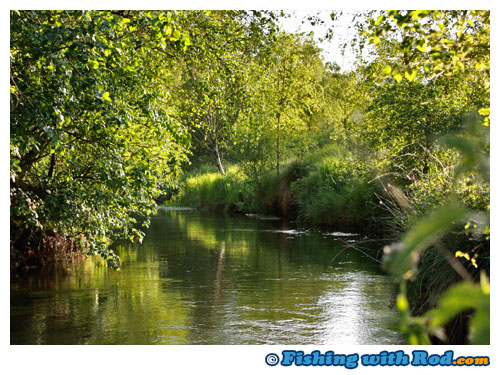
Heavily covered, a flyfisher’s nightmare.
By this point, optimism had turned into anger. Fly number two was now donated to the same tree. I retied and began sending it back upstream. This time, I paid great attention to the tree behind me, but had forgotten the overhanging one upstream from me. I overshot the cast and the fly wrapped itself around the branch! I looked on with disgust and broke the fly off, sending a pile of leaves into the water. Any chance of getting a rise had probably vanished with that performance.
Feeling quite hopeless, I decided to walk back downstream and continue further down to the stretch where I had not gone before. On my way down, I met a gentleman who has fished this particular stream for 30 years. We chatted briefly and I asked for some pointers. After all, local knowledge is the best one could ask for. He explained that the grayling population has improved tremendously in the last decade. Fish up to 50cm have been caught. Although the fish are plentiful, catching one is another story. As I had suspected, even with the access fee, angling pressure is quite high so fish become pretty educated as a result. A good day of fishing usually means catching a few fish. Coming from BC, that definition seems alien to me, since a good day of fishing actually means catching dozens of fish. Can you say spoiled?
After a quick chat, I continued downstream. The river became less meandering and vegetations along the banks were not as thick. Casting and fishing is easier in this situation, but would this less structured water hold just as many fish? Feeling that the air remained cool, I decided to switch to a nymph and casted as I walked down the river. After a dozen or so casts, I felt a quick tug and a tiny trout leaped out as I set the hook. It popped itself off as quickly as it got on, but it lifted the spirit slightly.
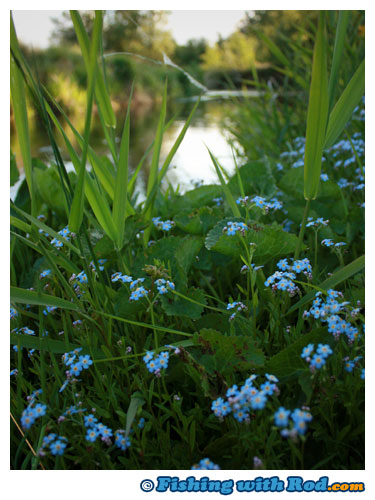
I continued on and took a peek over the steep bank at times. Soon after, I spotted a large grayling when I looked down. It was at least 18 inches in length. The grey body blended in with the clay background very effectively, making it appear and disappear under the dim light like a ghost. I rushed back up the river slightly, so I could position the nymph in front of this fish. Again, it was not so interested in my offering, which wasn’t too surprising.
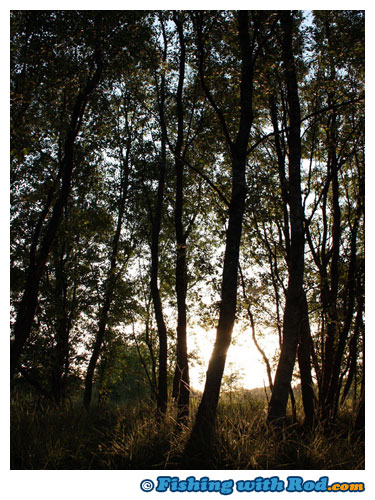
A Nordic summer evening.
While still attempting to trigger this fish to bite, I heard a solid splash further downstream. I looked up and spotted the ripples from that rise. It was 10:00pm, perhaps this is when the evening feed begins? I retied on the dry fly and made my way down the river until I was ten metres downstream from the rise. I browsed through the water and found the entire river bed void of weeds except the edges. Where could this fish be?
Not knowing where it was, I casted blindly into the structureless water. I could not see signs of fish in the first several drifts, then suddenly a rather large brown trout darted out of the weed! It positioned itself in the middle of the shallow channel and slowly drifted backward. It was clearly aiming for the dry fly. I looked on nervously. Was it going to take it? As the fly reached its striking zone, this fish rose slightly but turned away just before it reached the fly. Even though the lighting was low, it must have figured out the game.
The evening session ended without much more excitement. Not a single rise could be seen. A few more grayling were spotted in the water, but they were just as tight lipped.
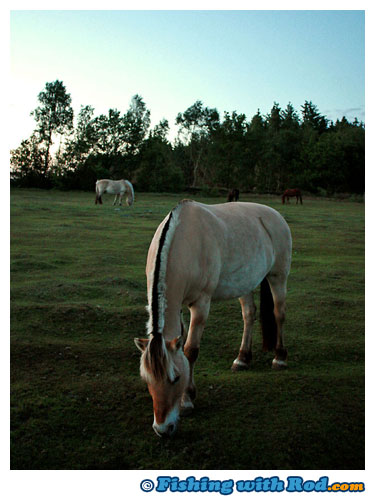
Grazing horses by the river.
The goal of this trip was certainly accomplished. Another new species is added onto my list. A few more catches would have been nice, considering the amount of expenses needed for the trip. Some say a memorable catch is priceless, perhaps I will think so in a few years from now. What this trip has made me believe even more firmly, is that British Columbia indeed offers the most productive freshwater fisheries at the lowest price. It is difficult to realize and appreciate this until you are given the chance to experience foreign fisheries and make comparisons.
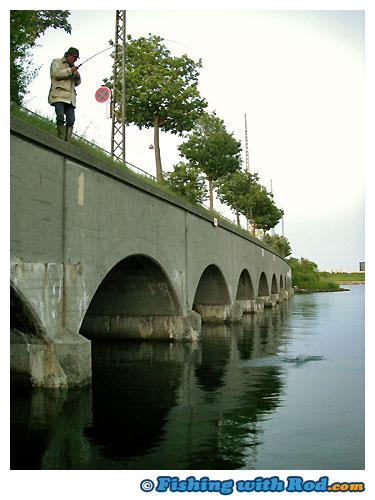
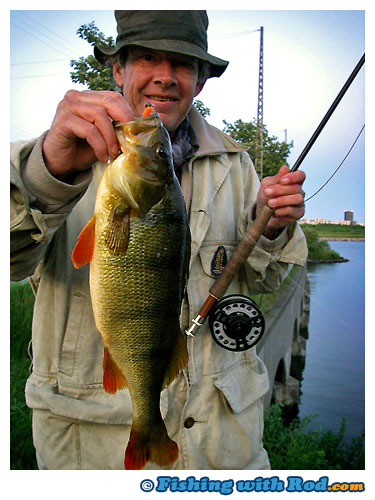







 Â
 








